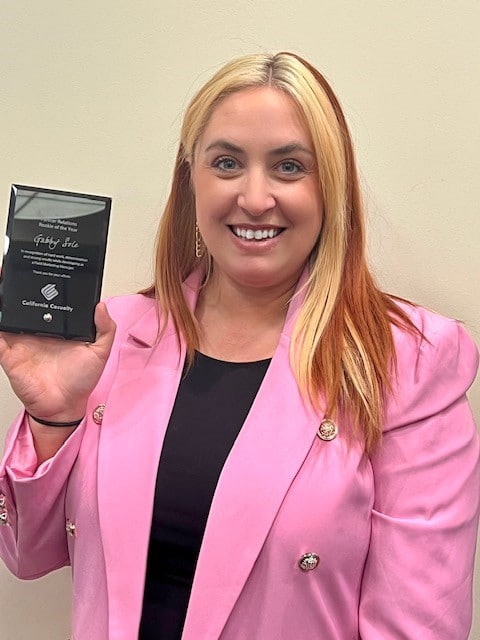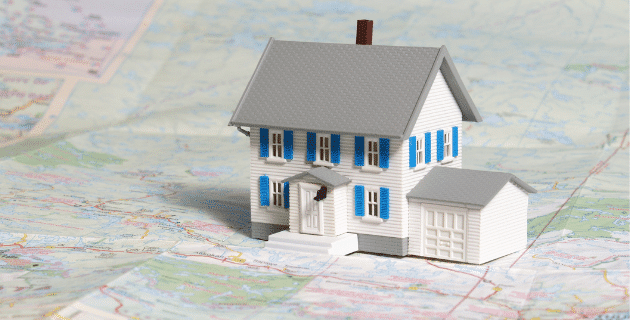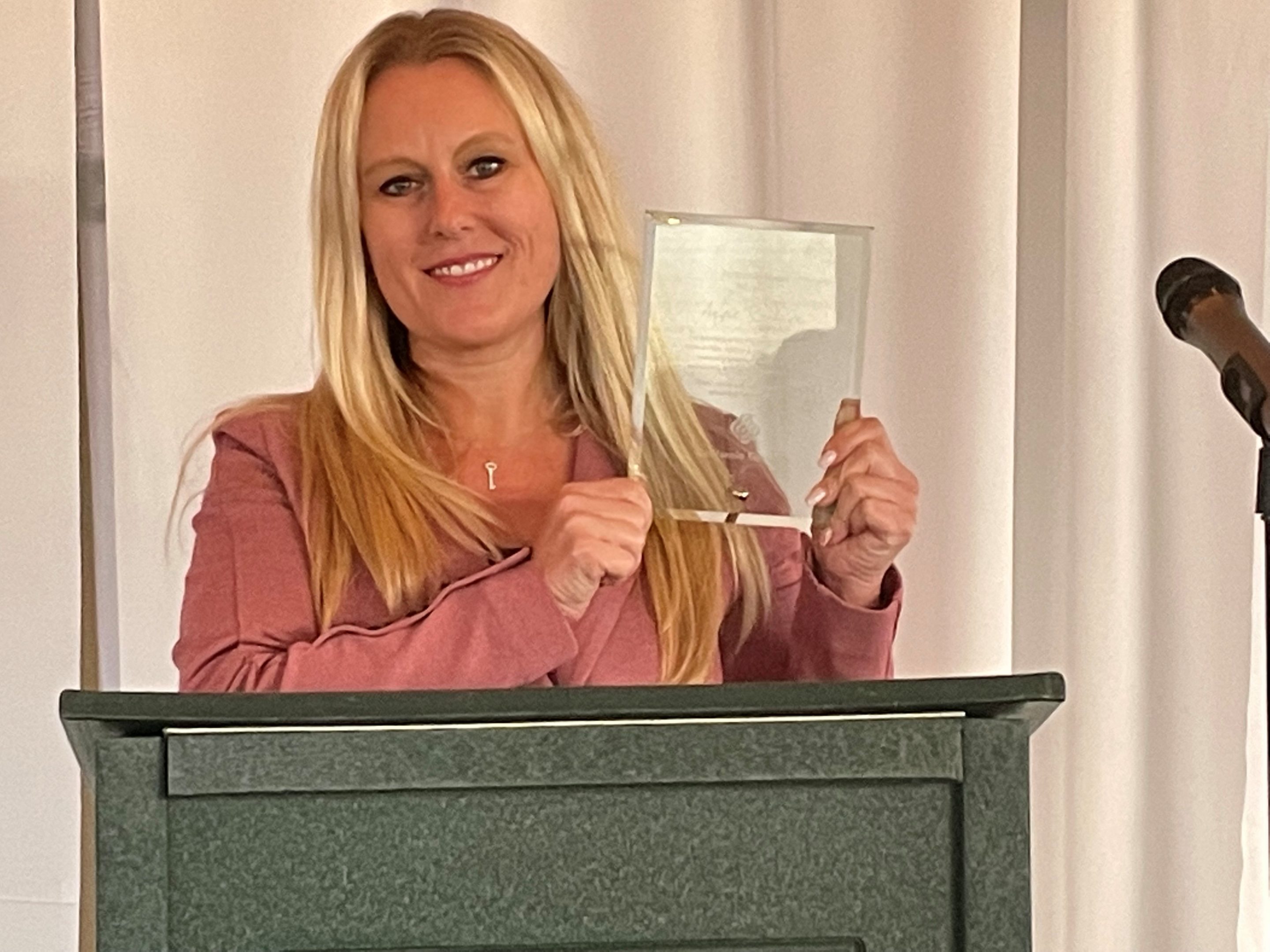
by California Casualty | News |
In 2021 the California Casualty Partner Relations Department recognized several employees in three separate categories: Mountain Mover, Rookie of the Year, and Partner Relations Advocate. These employees were selected for demonstrating some or all of these qualities; their commitment and dedication to serving our group partners by developing and nurturing relationships, creating leader advocates supporting company goals, managing their territory strategically, and delivering extraordinary customer service.
The Mountain Mover was the most prestigious award given and is selected by the Partner Relations Management Team. Angela Morgan (ID & WA), was selected as the 2021 Mountain Mover for the qualities listed above in addition to demonstrating teamwork, a strong work ethic, and a high level of integrity. Brian Goodman, Angela’s manager, stated that she is a “hardworking, fearless territory manager,” and added, “how she manages her business each and every day is inspiring.”

The Partner Relations Management Team also selected one individual within their first three years of service to the department for the Rookie of the Year. Gabby Sole (KS & OK), received this honor based on her results and activity. Gabby’s manager, Shawn Courtney, commented, “Gabby demonstrated a talent to build relationships with leaders and identify opportunities to a path of success.”
Nominated by a Partner Relations manager or fellow peer, the 2021 Partner Relations Advocate Award recipients were Angie Rajczyk (CA), Christina Ramos (NJ), and Michelle Hawkins (WA).
Angie has been a fixture in her northern California territory for over eleven years and is well respected among the various group leaders, fellow business partners, and her colleagues. Brian Goodman noted “Angie is a versatile leader that, has a calm and effective way of accomplishing her goals. These qualities have been the drive behind her success.”
Since her hire date nearly five years ago, Christina has generated remarkable production results in her New Jersey and Delaware territory. She is extremely hardworking and passionate about her job responsibilities and relationships. Christina’s manager, Amy Grosso, shared, “Christina’s commitment to high-quality work shines through each day. The access and opportunities that she has secured is impressive and motivating.”

With seven years of experience in her Washington territory, understanding advocacy and how leveraging relationships affects field access, retention, business growth, and her overall marketing plan is Michelle’s key to success as an advocate. Brian Goodman, Michelle’s previous manager stated, Michelle, is one of our very best. She knows exactly what she is doing and is a fantastic Partner Relations Advocate.”
As we finished a second year of uncertainty, the efforts of these individuals stood out as they continued to adapt to an ever-changing environment. Congratulations to all the 2021 Partner Relations award recipients!
This article is furnished by California Casualty, providing auto and home insurance to educators, law enforcement officers, firefighters, and nurses. Get a quote at 1.866.704.8614 or www.calcas.com.

by California Casualty | Homeowners Insurance Info |
Droughts, fires, floods, and storms – natural disasters can wreak havoc on your home and your property. Yet, many of us live in regions that are prone to them. If you live in such a place – or if you’re considering moving into one – how do you protect your investment?
Two ways: 1. Know your risks. 2. Have the right protection.
Know Your Risks: Is your region prone to a natural disaster?
A natural disaster can happen anywhere at any time. Weather patterns in a region are a good predictor of whether your area will likely be at-risk now and in the future.
The average weather pattern in a place over several decades is called a climate. An area’s climate affects the weather and the type of natural disaster(s) they are prone to. For example, we know the West has a very dry climate that causes frequent wildfires; the Northwest is known for its wet weather, which could lead to severe flooding. The Midwest is associated with brutally cold winters which can lead to devastating winter storms. And the warm coastal climate of the South East is the prime environment for hurricanes.
If you want to know the most common weather risks to your home or in your area, you can do a free climate risk assessment on ClimateCheck.
Know Your Risks: 6 Common Disaster Risks
Disasters come in many forms, from tornadoes and hurricanes to floods and droughts. Following are six types of disaster risks that may affect your home or property.
1. Heat Risk
Extreme heat occurs when there is high heat and humidity, and temperatures exceed 90 degrees for a period of days. In terms of disasters, extreme heat can sometimes lead to fires. (See the Fire Risk section for more detail.) U.S. counties with the greatest risk for heat include 37 counties in the south with a third of them located in Florida.
2. Drought Risk
Droughts occur when there is not sufficient precipitation. Not only does this put a stress on the water supply, but it can also have a severe impact on your landscaping. Soil dryness can also lead to settling issues with your home’s foundation. Unfortunately, for most homeowner policies, settling or shrinking is not a covered loss. U.S. counties with the greatest risk for drought include 34 counties in the west, with 21 in Colorado.
3. Fire Risk
When drought occurs and heat becomes extreme, the conditions are right for a fire to start. Wildfires can destroy your home or community. Wildfires account for about $16.5 billion in damages annually in the U.S. In the event of a fire caused by a natural disaster, your home’s dwelling coverage will pay to repair or rebuild your home up to your policy limit. U.S. counties with the greatest risk of fire are located in the West.
4. Flood Risk
This includes coastal flooding as well as flooding from surface water or nearby lakes and streams. Rising sea levels and extreme weather have contributed to flooding, which cost as much as $20 billion annually in the U.S. A traditional homeowner’s policy does not cover flooding. For your home to be covered you will need to purchase a separate flood policy. U.S. counties with the greatest risk of flooding are mostly located in the south, including Florida, Louisiana, and North Carolina.
5. Severe Storm Risk
Storms include high wind, wet or snowy weather events. These could be hail storms, hurricanes, tornadoes, or other types of destructive weather. Storm damage in the U.S. averages about $17 billion annually. Your homeowner’s policy may cover some aspects of storm damage, including hail, wind or lightning. If you are unsure, check with your insurance’s Service Department to see what is covered under your policy. U.S. counties with the highest risk of storms are located in the Northeast or Southeast.
6. Earthquake Risk
Earthquakes typically occur along fault lines and can cost millions in damages. In the U.S., they are more common in California and Alaska. A pair of earthquakes struck Ridgecrest City, California, in 2019, causing nearly $40 million in damage. Importantly, while earthquakes cause significant damage to buildings and property, they are not covered by the typical homeowner’s policy. In some states, however, you can purchase coverage for earthquakes for an additional premium.
Have the Right Protection: Do you have enough insurance for a disaster?
If a natural disaster happens in your community, and your home and property are damaged, you want to be able to rebuild. Yet, many homeowners find themselves having to fund portions of the rebuilding process because they’re underinsured. Here’s what you need to know.
-
- During a disaster, your neighbors will be rebuilding at the same time. When demand exceeds supply, that can drive up prices for materials and labor. These increased costs usually aren’t factored into homeowner’s coverage, and you have to pay out of pocket for the difference. Some policies carry a mandatory endorsement added to the policy that provides an additional 25% of coverage to cover these additional costs. There is a fee for this endorsement, known as extended repair/replacement cost.
- You may be required to meet new and stricter building codes when you rebuild. You may use up to 10% of Coverage A for the increased costs you incur due to the enforcement of any ordinance or law. For an additional premium, increased amounts of coverage can be purchased via an endorsement.
- If your area is prone to floods or earthquakes, you will want those additional policies. Your homeowner’s policy does not cover these events. Keep in mind that there is a 30-day waiting policy for flood insurance.
- Rebuilding a home can take a long time. Your policy’s living expense coverage will provide a flat percentage toward living costs, usually 30% of the Coverage A amount. Some states have time limits (e.g. 12 months) on when you can use that coverage. Plan to cover those additional expenses out of pocket.
You want to be fully prepared for a disaster, and not just with a disaster plan. Talk with your insurer about your home and property to ensure that you are fully covered, no matter which location you call home.
This article is furnished by California Casualty, providing auto and home insurance to educators, law enforcement officers, firefighters, and nurses. Get a quote at 1.866.704.8614 or www.calcas.com.

by California Casualty | Homeowners Insurance Info |
You want to do your part by helping the environment. That’s why going green sounds so good! But why is it that in reality, we often skip the trip to the recycling bin after a few days and hit the trash instead? (oops…)
Forming and continuing good habits is the key to encouraging recycling- even when you’re feeling lazy or in a hurry. Try these recycling organization hacks at home and on the job, to make recycling a part of your everyday routine.
Get a recycling bin and learn your local regulations.
Call your trash provider and ask about getting a recycling bin. Different municipalities have different rules for separating recyclables. These include paper, plastic, glass, and some metals. Use these rules as a guide to create a recycling plan. Make a list and post it for easy reference. If you’re in the office, look for recycling bins in common areas or talk to your manager about getting a small bin for your desk.
Designate containers for each type of recycling.
Label each container clearly. If you’ve got small children, color code the containers or put pictures on them in addition to words. Choose containers that are easy to use. For example- containers with wheels can be easily moved, those with comfortable handles that can be easily lifted, stacking containers take up less floor space -etc. The easier it is, the more likely you will be to use it.
Carefully choose the locations for your containers.
If a recycling container is not nearby, you may be tempted to use the trash can. At home, put recycling bins in high usage spots such as the kitchen, bathrooms, the laundry room, and home office. In the office, you can put a paper recycling bin in the copy room, a plastic recycling bin in the break room, and so on. Ask your fellow employees for the best places to put the bins in terms of how they use the workspace. Make sure the bins are visible and easy to access.
Leave recyclables in the sink to rinse when you wash your dishes.
Whether it’s in your home kitchen or the office break room, you will likely have recyclable food containers with food residue. These need to be cleaned before they hit the recycle bin. At home, it’s easy to throw the empty containers in the sink and rinse them when you do the dishes. At the office, that won’t work as well… get in the habit of rinsing your containers as soon as you are finished with them and putting them in the recycling bin.
Be as digital as possible.
Adopt a paper-conscious policy at home and in the office. Discourage printing unless absolutely necessary, and when you do, print on both sides. The less paper you use, the less you have to recycle. Plus, there are so many wonderful options from calendars to bill paying, digital file-sharing, and more. There’s even an app to help you manage your waste and recycling schedules, set up reminders, and more.
Keep reusable bags in your car and at the office.
If you’re heading out to buy some groceries or pick up supplies for the office, bring your own reusable bags! You won’t need to use the store’s disposable bags, thus reducing the amount of waste you generate. Be aware of stores’ collection sites for batteries, ink cartridges, and plastic bags, and bring those along. (Pro tip: Collect them in one of the reusable bags that will you take to that store.)
Create a compost bin for your kitchen.
Composting is good for the earth. You can create your own simple compost container from a coffee can placed near your kitchen sink. Simply add fruit and vegetable peels, coffee grounds, eggshells, old oatmeal, bread crusts, and other items that will decompose. Then periodically transfer the contents of the can to a larger compost bin outside. You can then use it to fertilize your garden or landscaping.
Reduce, reuse, & recycle your office supplies.
Set up a space for used office supplies that can still be reused. Ask employees to check this space first before getting new supplies. In addition, you can buy recycled. Replace standard products with recycled products; oftentimes, it will save you money.
Make recycling a fun challenge.
Generate excitement about recycling with a challenge. If everyone else is motivated to recycle, then you won’t have to stay on top of them. They’ll do it themselves. At work, run a weekly contest by department to see how many recycling bins can be filled, or how much less trash is generated. Choose a recyclable of the week, and award departments that recycle the most. Recognition can include signage and perks such as leaving early, working from home, and free lunches. At home, reward environmentally-conscious kids with a special treat, later bedtime, or a family outing.
While you go green indoors, make sure your vegetation is staying green too! Use this guide to easily check the health of your trees and large shrubs, and avoid a possible future homeowner’s claim.
This article is furnished by California Casualty, providing auto and home insurance to educators, law enforcement officers, firefighters, and nurses. Get a quote at 1.866.704.8614 or www.calcas.com.

by California Casualty | Auto Insurance Info |
When you take your motorcycle out on a beautiful day, you can enjoy it all — the open road, the sunshine, the fresh air, and the calmness of the ride. But when you take your bike out on a windy day, it’s a much different experience.
Not only can the wind be cold and uncomfortable for riding, but it can also make it more challenging to maintain control. In fact, riding your motorcycle in the wind can be such a nerve-wracking journey that it might make you decide to skip the trip entirely. However, there will be times when you get caught on a windy day or when your bike is your only option. Follow these tips to stay safe when riding your motorcycle in the wind.
Tip #1: Prepare in advance for a windy ride.
-
- Minimize the amount of baggage that you carry. Saddlebags, backpacks, and even your clothing can catch the wind, creating unnecessary drag.
- Secure loose items that could be easily blown away.
- Wear protective eyewear to shield your eyes from any windblown dirt or debris.
Tip #2: Check the weather.
-
- Wind speeds exceeding 50 mph are considered too dangerous for motorcycles, even heavier models.
- Wind speeds between 20 and 30 mph will be too much for most lightweight motorcycles.
- Avoid taking your motorcycle out during high wind warnings, hurricane-force winds, tornados, or other severe weather conditions.
Tip #3: Stay calm and in control.
-
- Don’t panic. Relax and try not to grip the handles too hard. Maintain a steady speed.
- Ride in the middle of the lane. Give yourself some space in case you move to the right or left due to wind gusts. Know that the other vehicles on the road could be moved by the wind, too.
- Know your abilities. If you’re inexperienced, or if you feel out of control, find a safe place to wait it out. Better safe than sorry.
Tip #4: Know the direction of the wind and how to adjust.
-
- You may be able to feel the direction of the wind. But if you’re unsure, look for things that are blowing: grass, the tops of trees, and flags. Note the direction the wind is blowing.
- If it’s a tailwind, it will push you from behind.
- Give yourself extra stopping distance. The wind could propel you forward as you’re trying to slow and stop.
- Watch your speed and stay in your comfort zone. You don’t want the wind to push you faster than you are comfortable traveling.
- If it’s a crosswind, it comes from the sides.
- This is the most difficult type of wind. It can come to you from either side, or both.
- Shift your weight to the side the crosswind is coming from and lean into it slightly. Do it carefully so you don’t affect your balance.
- Using your leg on the side the wind is coming from, turn your knee in the direction the wind is blowing. Your leg acts as a sail and the wind won’t push you as hard.
- If it’s a headwind, it’s coming to you from the front.
- Headwinds are stronger than the wind that usually comes at you from the front.
- Ride low behind the windshield.
- Keep your legs and arms close to your body and to the bike.
Tip #5: Be aware of wind fluctuations.
-
- The wind direction can change at any time. Be prepared to adjust accordingly.
- If you’re behind a large truck, it will block the wind from you somewhat. Be prepared for a wind gust as you move away from the truck.
- Remember the rules about sharing the road with others. Add extra distance when it’s windy in case you need it.
Tip #6: Certain places are windier than others.
-
- Winds are generally higher in the hills and lower in the valleys.
- Roads with hedges and other barriers can help to protect you from the wind.
- If the open road is too windy, see if there is another route you can take that is more sheltered.
Windy conditions can contribute to accidents. Make sure your bike is fully protected with the right amount of motorcycle insurance. Safe travels—and enjoy the ride.
This article is furnished by California Casualty, providing auto and home insurance to educators, law enforcement officers, firefighters, and nurses. Get a quote at 1.866.704.8614 or www.calcas.com.
by California Casualty | Auto Insurance Info |
We have amazing employees at California Casualty. The New Employee Spotlight is a series aiming to highlight the talented individuals that are brand new to our team. Please help us give them a warm welcome!
Today we’re spotlighting New Inbound Sales Representative. Carrie Fierro
Let’s get to know, Carrie!

Where are you from?
Originally from San Angelo, Texas
What is one interesting fact you want us to know about you?
I have a super friendly, talkative, upbeat personality. Since the time I could talk my mom said I would just walk up to anyone and introduce myself. I guess I was kind of born to be in sales. haha!
If you could eat one food for the rest of your life, what would it be?
Chicken enchiladas
What do you like to do on the weekends?
Hiking
Spending time with my children
Reading romance novels
What made you want to start your new career with California Casualty?
Their awesome benefits and pay scale were above the average for the Colorado Springs area and they gave me a shot even though I was coming all the way from Texas!!
If you want to learn more about Carrie or are interested in a career at California Casualty, connect with her on LinkedIn! Or visit our careers page at https://www.calcas.com/careers










